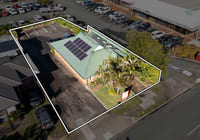
Industrial investment market to eclipse office by 2026
The total value of investment-grade industrial property in Australia is set to surpass the office sector for the first time in 2026 due to a combination of rising logistics real estate values and the completion of new super-sized facilities to cater for the growth of ecommerce.
Between now and 2026, the Australian industrial and logistics universe is forecast to rise 48 per cent from $286 billion to $424 billion, according CBRE Research.
Over the same time frame, the combined value of investment-grade office buildings is forecast to grow at a more modest pace, rising from $350 billion to about $420 billion, according to CBRE.
CBRE does not provide a forecast for the value of investable retail property by 2026, but it is currently lower than the industrial sector at $260 billion and likely to fall further behind given the continued impact of online retailing on demand for bricks-and-mortar retail space and weaker valuations.
Sass J-Baleh, head of industrial & logistics research at CBRE, said a key driver of the capital value uplift in industrial property over the next four years was expected to be stronger rental growth, a trend already occurring on the East Coast where vacancy rates are at record lows.
“We forecast an annual average growth rate in national rents to be approximately 6.5 per annum between now and 2026, with the strongest rent forecasts in the Sydney market,” Ms Sass J-Baleh said.
The surge in valuations has been highlighted in the interim and annual results posted by listed players Goodman Group, Charter Hall, Centuria Industrial REIT and Dexus all of whom have booked massive increases in the value of their industrial property books.
These same groups, along with likes of Pan-Asian giants ESR, Logos and Frasers, are also investing billions in developing new state-of-the-art automated logistics facilities for clients such as Amazon, Coles and Woolworths.
Forecasts that the investable industrial property universe will exceed office by 2026 follows another “changing of the guard” moment last year when returns – or yields – on prime warehouses fell below those for top CBD office towers for the first time (4.75 per cent versus 5 per cent) a reflection of the weight of capital seeking to increase its exposure to logistics and a lack of supply to meet that investment demand.
The decline in the cumulative value of retail property relative to industrial property has been underway for some time due to the rise of Amazon and other online giants at the expense of people going to shopping malls.
This was reflected in Australia when Goodman Group’s market valuation surpassed that of Westfield owner Scentre Group in January 2019.
That gap has since widened massively with Goodman valued at $36.3 billion (it was as high $49.5 billion at its market peak in December 2021) while Scentre Group is worth less than half that at $14.9 billion.
Dexus, the country’s biggest listed owner of office property (as well as industrial and other commercial assets) has a market cap of $11.5 billion.











